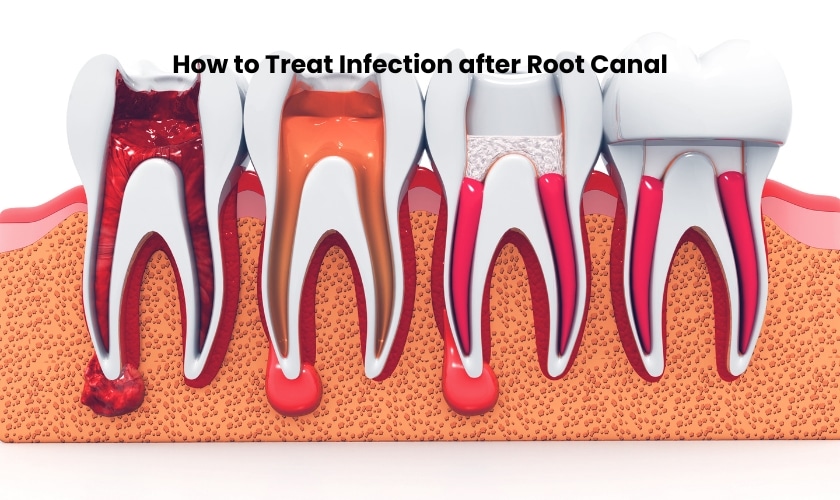
Root canals are a common dental procedure designed to save a severely infected or decayed tooth. By removing the infected pulp and cleaning the root canals, dentists aim to eliminate the source of pain and preserve the tooth’s structure. However, in some cases, an infection can develop even after a root canal treatment. While this may seem concerning, it’s important to remember that treating an infection after a root canal is possible.
This blog post will equip you with the knowledge you need to navigate this situation. We’ll discuss the signs and symptoms of an infection after a root canal, explore treatment options, and provide helpful tips for managing discomfort and promoting healing.
Understanding Root Canal Infections: Causes and Symptoms
While root canals are highly successful, a small percentage (around 3%, according to a study published in the Journal of Endodontics) experience post-treatment infections. Several factors can contribute to this, including:
- Incomplete cleaning: During the root canal procedure, the dentist aims to remove all infected pulp tissue. In some cases, however, microscopic canals or hidden pockets of infection might remain.
- Fractures or leaks: If a tooth cracks or the temporary filling leaks after treatment, bacteria can re-enter the root canals and cause reinfection.
- Improper restoration: A permanent crown placed on the tooth after the root canal helps seal it and prevent further infection. If the crown isn’t placed correctly or delays in placing it occur, bacteria can enter the tooth.
Here’s what to watch out for if you suspect an infection after your root canal treatment:
- Throbbing toothache: This is a common symptom and can be severe.
- Sensitivity to hot and cold: The tooth might become extremely sensitive to temperature changes.
- Swelling in the gums or face: This can be a sign of a spreading infection.
- Tenderness when biting: The tooth might feel tender or uncomfortable when chewing.
- Bad breath or pus drainage: A foul odor or pus coming from the treated tooth can indicate an infection.
If you experience any of these symptoms, it’s crucial to schedule an appointment with your dentist immediately. Early diagnosis and treatment are essential to prevent the infection from spreading and potentially causing further complications.
How to Treat Infection after Root Canal
Once your dentist confirms an infection after a root canal, they’ll recommend the most suitable treatment based on the severity of the infection and the specific situation. Here are the two main approaches:
1. Antibiotics:
In most cases, the first line of defense against infection after a root canal involves antibiotics. Your dentist will prescribe a specific antibiotic medication to target the bacteria causing the infection. It’s vital to complete the entire course of antibiotics as prescribed, even if your symptoms improve quickly. Stopping them prematurely can allow the bacteria to become resistant, making them harder to treat in the future.
2. Re-treatment:
If antibiotics alone don’t resolve the infection, your dentist might recommend a retreatment of the root canal. This involves reopening the tooth, removing any remaining infected tissue, cleaning the canals again, and resealing the tooth with new filling materials. In some cases, additional procedures like surgery might be necessary to address complex infections or anatomical challenges.
Here are Some Questions About Treating an Infection After a Root Canal:
1. How long does it take to treat an infection after a root canal?
This depends on the severity of the infection. Typically, a course of antibiotics takes around a week, while retreatment can take longer depending on the complexity of the case.
2. Will I experience pain during the retreatment procedure?
Your dentist will administer local anesthesia to numb the area and minimize discomfort during the procedure.
3. What can I do to manage the pain after a root canal infection?
Over-the-counter pain relievers like ibuprofen or acetaminophen can help manage discomfort. Applying a cold compress to your cheek near the affected tooth can also provide temporary relief.
4. Can I eat normally after a root canal infection?
Stick to soft foods that are easy to chew while your mouth heals. Avoid hard or chewy foods that might irritate the treated tooth.
5. How can I prevent an infection after a root canal?
Practice good oral hygiene by brushing twice a day and flossing daily. Maintain regular dental checkups and cleanings, and promptly address any cracks or chips in the treated tooth to prevent bacteria from entering.
Promoting Healing and Preventing Future Infections
Following a successful treatment for an infection after a root canal, it’s crucial to focus on promoting healing and preventing future issues. Here are some key steps to take:
- Maintain good oral hygiene: Brushing twice a day with a fluoride toothpaste and flossing daily are essential to remove plaque and bacteria that can contribute to reinfection.
- Pay attention to your diet: Avoid sugary or acidic foods that can irritate the treated tooth and contribute to bacterial growth. Opt for a balanced diet rich in fruits, vegetables, and whole grains to support overall health and healing.
- Schedule regular dental checkups: Don’t skip your regular dental appointments! These allow your dentist to monitor the treated tooth and ensure there are no signs of reinfection.
- Address any concerns promptly: If you experience any discomfort or swelling around the treated tooth, contact your dentist immediately. Early intervention can prevent minor issues from escalating into more serious problems.
Conclusion
Experiencing an infection after a root canal can be frustrating, but it’s important to remember that it’s a treatable condition. By understanding the signs and symptoms, treatment options, and preventative measures, you can navigate this situation effectively and regain your oral health.
Don’t hesitate to discuss any concerns you have with your dentist. Open communication and a proactive approach to oral hygiene are essential for ensuring the long-term success of your root canal treatment and maintaining a healthy smile.
